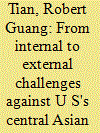| Srl | Item |
| 1 |
ID:
091074


|
|
|
|
|
| Publication |
2009.
|
| Summary/Abstract |
To penetrate and maintain peaceful development of the Central Asian region is a consistent goal of the United States for its international interests. With the 9/11 event as the baseline, since 2001 America's awareness of the strategic importance of Central Asia and the latter's weight in U.S. global strategy has been greatly changed. According to Charles Manes, the 9/11 terrorist attack enabled the U.S. to "discover Central Asia." As a result of this discovery the United States effectively gained a foothold in Central Asia. However, the U.S. has been so impatient that it made a policy mistake. In supporting the Color Revolution in order to change the political system in Central Asian countries, it promoted democratization in the region in too great a rush.
|
|
|
|
|
|
|
|
|
|
|
|
|
|
|
|
| 2 |
ID:
088549


|
|
|
|
|
| Publication |
2009.
|
| Summary/Abstract |
With the 9/11 event as the baseline, America's awareness of the strategic importance of Central Asia and the latter's weight in the U.S. global strategy was greatly changed. According to Charles Manes, the 9/11 terrorist attack enabled the U.S. to "discover Central Asia." This attack has straightened out the uncertainty due to confusion within the U.S. Government about the importance of the Central Asian area to the U.S. and enabled the U.S. to suddenly realize the important advantage of the five Central Asian nations in the global geopolitical pattern. However, the sympathy of the Central Asian nations, Russia and China for the U.S. on the terrorist attack and the warm help from the Central Asian nations to U.S.'s Taliban attacks in Afghanistan and to the U.S. military actions against al-Qa'eda, facilitated the U.S. army in Central Asia to gain the Manas Air Base and the Karshi Khanabad Airport (also called K2 Base). This symbolized a turning point for the U.S. to access the Central Asian area in one stroke. By stationing in Central Asia, the U.S. became a remarkably important power in Central Asia and nearby
|
|
|
|
|
|
|
|
|
|
|
|
|
|
|
|
| 3 |
ID:
088533


|
|
|
|
|
| Publication |
2009.
|
| Summary/Abstract |
The Central Asia region mainly consists of the five Central Asian republics, namely Kazakhstan, the Kyrgyz Republic, Tajikistan, Turkmenistan, and Uzbekistan. The region is located in the center of the Eurasian continent. It borders to the north on the Russian Federation, to the south on Iran and Afghanistan, and to the east on the Xinjiang Uighur Autonomous Region of the People's Republic of China (PRC). Mongolia lies in the upper portion of the PRC; while Azerbaijan, a member of the Caucasus, lies to the west of the region near Turkmenistan.
|
|
|
|
|
|
|
|
|
|
|
|
|
|
|
|